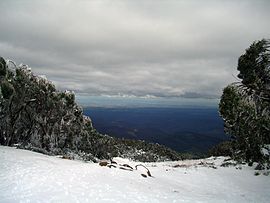Baw Baw plateau
|
Baw Baw National Park Victoria |
|
|---|---|
|
IUCN category II (national park)
|
|

|
|
|
Location of the Baw Baw National Park in Victoria
|
|
| Nearest town or city | Rawson |
| Coordinates | 37°45′50″S 146°13′23″E / 37.76389°S 146.22306°ECoordinates: 37°45′50″S 146°13′23″E / 37.76389°S 146.22306°E |
| Established | April 1979 |
| Area | 135.3 km2 (52.2 sq mi) |
| Managing authorities | Parks Victoria |
| Website | Baw Baw National Park |
| See also | Protected areas of Victoria |
The Baw Baw National Park is a national park located on the boundaries between the Central Highlands and Gippsland regions of Victoria, Australia. The 13,530-hectare (33,400-acre) national park is situated approximately 120 kilometres (75 mi) east of Melbourne and 50 kilometres (31 mi) north of the Latrobe Valley. The park contains the Baw-Baw Plateau and Mount Baw Baw, a small ski resort.
Geographically, the Baw-Baw Plateau is a plateau of several peaks that includes Mount Baw Baw, Mount St Gwinear, Mount St Phillack, Mount Erica and Mount Whitelaw; all largely subalpine terrane outcrops of weathered granite boulders dot the plateau with alpine meadows punctuated by stands of snow-gum. Much of the slopes of the plateau within the national park form the catchment area for the Thomson River and the Thomson Reservoir, and the Tanjil and Tyers rivers.
The traditional custodians of the land surrounding Baw Baw National Park are the Wurundjeri people of the Kulin Nation. Through their cultural traditions, the Gunaikurnai people identify the Baw Baw National Park as their traditional country.
The area was first explored by Europeans in 1860 by botanist Ferdinand von Mueller. The area was settled in the 1880s and 1890s, after the discovery of gold in the area. Baw Baw National Park was declared in April 1979. On 7 November 2008 the park was added to the Australian National Heritage List as one of eleven areas constituting the Australian Alps National Parks and Reserves. The Baw Baw National Park represents the southerly extent of the sub-alpine environment on mainland Australia.
...
Wikipedia

